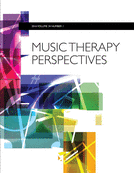-
Views
-
Cite
Cite
Megan E. Graham, Toward a Practice of Engaged Filming in Nordoff-Robbins Music Therapy, Music Therapy Perspectives, Volume 34, Issue 1, 2016, Pages 64–70, https://doi.org/10.1093/mtp/miu052
Close - Share Icon Share
Abstract
The practice of video-recording music therapy sessions is important for clinical work, research, training, and education, as well as professional presentations. This paper discusses the origins of filming music therapy sessions in the Nordoff-Robbins approach, and then takes up the art and craft of filming, drawing on key authors from the field of sound studies. Following Altman (1992) and Lastra (2000), filming is the creation of a representation, not a reproduction or copy, and the construction of the video recording and engagement of the videographer in the music therapy session are important. The topic of intelligibility and recording will be discussed with regard to sound levels and matching the visual image to the musical activity in order to create the best possible representation of the session’s narrative. Further, the importance of the recording as a representative document is emphasized as both a tool for professional development and a gift to clients and their families.





